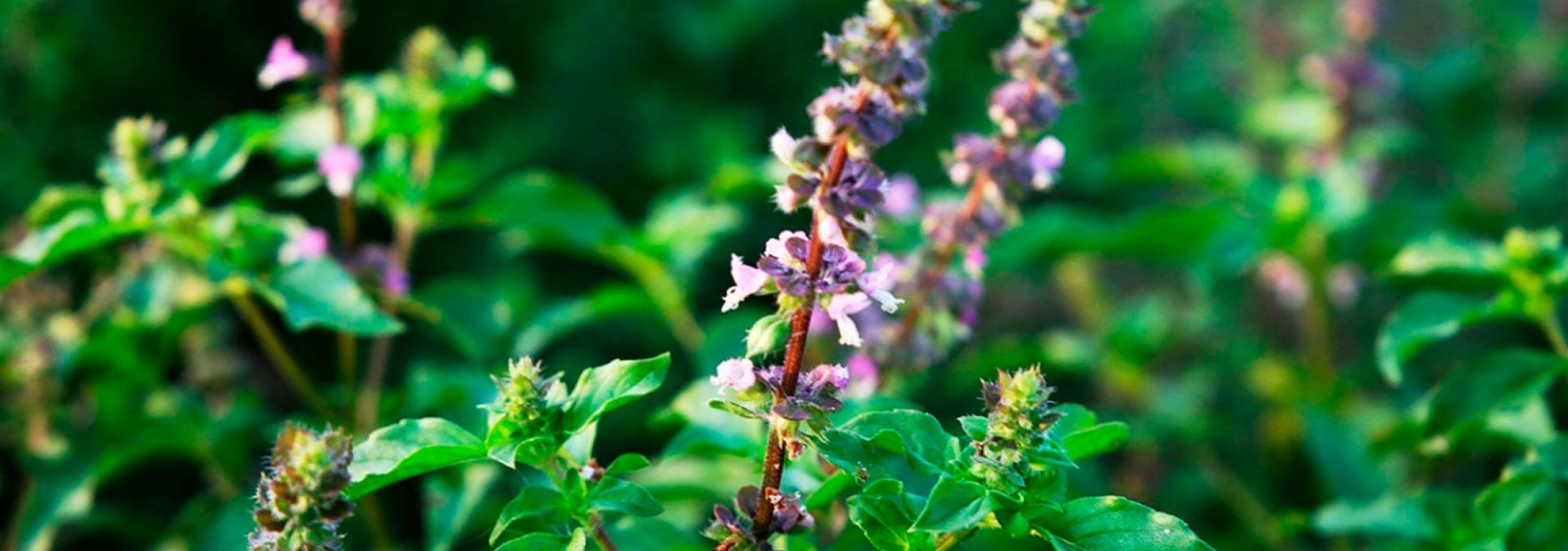
Tulsi: the divine herb
Imagine a plant that’s considered sacred and at the same time it possesses medicinal and culinary qualities. This would be tulsi or tulasi (Ocimum sanctum or O. tenuiflorum), originally from India, but found all over the Asian southeast. Its name means “incomparable” and has been cultivated since ancient times because it embodies the goddess of wealth and abundance, and also for its medicinal properties and its essential oil. The Indian basil or tulsi is a little bush which grows no more than 60 cm high and its aromatic leaves are green or purple.
There’s a tulsi bush in every Hindi household and the first thing done after lighting the domestic altar’s oil lamp, is to water the plant which represents Lakshmi, the goddess of wealth and wife of Vishnu, keeper of the universe. Tulsi is considered to attract prosperity, to invite the presence of the gods and to purify the air. It is planted around temples for this reason. Many light a Little lamp each evening as a symbol of reverence, especially during the month of Kartik (mid-October to mid-November), as well as on Thursdays and Fridays, days dedicated to Lakshmi. The vaishnavas, the Vishnu and Lashmi devotees, wear japamalas (rosaries) made out of branches or roots of Indian basil, to the point which they are known as “the ones who wear tulsi around the neck”.
Regarding its therapeutic properties, its effects on a bodily level are most notable in the blood, the marrow, the nervous tissue and the reproductive system. In Ayurveda, Indian traditional medicine, it’s said it decreases vata and kaoha, and increases pitta. It has antibacterial, antipyretic and antispasmodic effects. It benefits skin, the digestive tube and the respiratory ways. Tulsi purifies, oxygenates and invigorates the body, it’s a cardiac tonic, it rids the organism from the effects of poison and it’s efficient in the early stages of many types of cancer. Its essence is used for the ears and it’s consumed in case of a cold, cough, asthma, hiccups, pleurisy and bronchitis in order for the body to expel mucus. Ayurveda recommends a teaspoon of the leaves’ juice along with a teaspoon of ginger and three grains of black pepper in case of a light fever, cough, chill and digestive disorders. It’s also considered an aphrodisiac and it alleviates the pain of dysmenorrhea.
On a mental level, its effects are more outstanding: the herb tulsi provides peace, serenity, lucidity and good memory. In Ayurveda, it’s particularly considered a brain and nerve purifier, and it’s one of the plants that calms and improves mental functions, alongside ashwagandha, gotu kola, aromatic quill and sandal.
Lastly, tulsi is used as a seasoning in every type of food, including soups and desserts.
Why does it have these marvelous properties? Tulsi contains, among others, oleanolic acid (hepatoprotective, with antitumor and antiviral qualities), ursolic acid (chardioprotective, it inhibits the proliferation of many types of carcinogenic cells, it increments muscle and reduces fat, it attenuates the brain’s oxidizing damage, potentiates the immune system and pancreatic function) and eugenol (antiseptic and mild sedative).
The three main varieties grown in India and Nepal are Rama tulsi (Occimum gartissimum), which is the most common, with wide light Green leaves and a mild sweet taste; Vana tulsi (O. basilicum), wild and widely spread, and Shyama or Krishna tulsi (O. sanctum), the rarest, with purplish Green leaves.
Written by: Ravi Chandra



